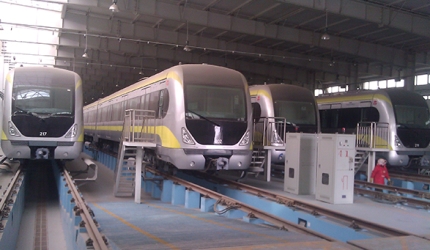
Tianjin Eco-City in China is a 30 square kilometre modern township project being jointly developed by the governments of Singapore and China. Located 45km east of Tianjin, the project will build 100,000 sustainable homes for 350,000 people. The entire project is set for completion in 2020.
The eco-city is being developed as a model for other cities in China. It will include residential buildings, leisure facilities, industrial parks and business parks. An environmentally sustainable concept was chosen for the eco-city to address the growing problem of pollution in the country. The project will use sustainable technologies, such as solar and wind power, wastewater treatment and sea water desalination, to reduce carbon footprints.
Sino-Singapore Tianjin Eco-City Investment and Development Corporation is the master developer of the project. It is a joint venture between Tianjin TEDA Investment Holding and the Keppel Group.
Master plan for the jointly developed Chinese and Singaporean township
The master plan for Tianjin Eco-City was jointly developed by the China Academy of Urban Planning and Design, the Tianjin Urban Planning and Design Institute and the Singapore Urban Redevelopment Authority.
Related project
Tohoku Sky Village Concept, Japan
Tohoku Sky Village is a conceptual design for a set of artificial islands in the Tohoku region of Japan.
The site for the eco-city was selected based on three criterions – non-arable land, water availability and commercial viability. Development of the city has been divided into five districts, with each district including residential buildings, office buildings and leisure centres.
About 80% of the project is dedicated to residential buildings, with the remaining 20% for commercial use and business parks.
The first phase of development includes the start-up area. The next phase is District 04, which includes the Eco-City Centre and Eco-Information Park.
Design for the eco-city encompassing business parks and urban centres
Design of the eco-city is based on four concepts, including an eco-valley, a water body development, five eco-districts and six urban centres.
Related project
Vanke Center Shenzhen, China
Vanke Center Shenzhen is a horizontal skyscraper located in Mirs Bay in Dameisha, Shenzhen, China.
Eco-valley is a 12km long, 50m wide man-made channel connecting the residential districts with the commercial areas from south to north. The city will include three water bodies – Qingjing lake, Ji canal and Old Ji canal. These water bodies will provide a habitat for wildlife and also act as recreational spots for residents.
Eco-districts are made of eco-cells and eco-communities. An eco-cell is 400x400m in size and can accommodate 2,500 dwelling units. Four such eco-cells make up an eco-community, consisting of 9,000 dwelling units. Four or more eco-communities make up an eco-district.
Each eco-district includes business parks to provide employment to people with an easy access to their homes. Eco-districts are also served by urban centres to provide amenities such as malls, schools, parks and recreational spaces.
Six urban centres of the city include the northern sub-centre, administration centre, eco-forum centre, eco-city centre, Qing Tuo Zi leisure centre and the southern sub-centre.
Construction of the Tianjin Eco-City by Keppel Group and others
Groundbreaking for the project took place in September 2008. The four square kilometre start-up area which is currently under construction, includes four neighbourhoods, an eco-business park, an eco-industrial park, one sub-centre, a hospital, a National Animation Industrial Park, the Qing Tuo Zi leisure centre and schools.
Related project
Tokyo Sky Tree, Japan
The Tokyo Sky Tree became the tallest free-standing structure in the world when it reached its final height of 634m in 2011.
The eco-business park will occupy an area of 26.6h. Jurong Consultant is the master planner of the park.
The start-up area of the project is expected to be completed by the end of 2013. Around 60 families have already occupied part of the start-up area of the project. By the end of 2012, another 6,000 homes will be ready to be occupied.
Keppel Group is developing a 36.6ha site in the start-up area which includes 5,000 homes, three office buildings and retail premises. Named Seasons City, the development was launched in October 2010.
Other projects include the 100h Wetland Century development undertaken by Shimao Property Holdings, the 9.78h Ayala project by Ayala Land, the 100h Farglory Project by Farglory Land Beijing, Sunway Project by Sunway Berhad, Jade Capital by Samsung C&T, Vanke Project, Vantone / TiangFang Project, Mangrove Project by Jiaming and Binhai Jia Yuan project.
Sustainability of China and Singapore’s ‘model’ eco-city
All buildings of the eco-city project feature an environmentally sustainable design and use green materials for construction. They are equipped with intelligent building systems, building energy optimisation, district cooling / heating systems, vacuum sewage systems and pneumatic waste collection systems.
A water reclamation plant will be built by Keppel Integrated Engineering. It will have a capacity of 100,000 cubic metres a day and will recycle wastewater from the city to national standards.
To ensure that the eco-city is a sustainable development, emphasis is being laid on public transport and use of non-motorised modes of transport. Tianjin Eco-City’s light rail system will help in achieving this aim.
Residents will be encouraged to use the tram system and other non-motorised modes of transport, such as bicycles. The transport network in the eco-city will include separate non-motorised and motorised networks to reduce conflict between pedestrians, cyclists and motorised vehicles.
Related content
Shaping the Shard: spider crane scales Europe’s tallest building
London’s newest landmark, the Shard, owes a substantial amount of its construction to a comparatively tiny crane.
Urban water design: strategies for future cities
Sustainably integrating water into modern cities will be one of the biggest challenges faced by future urban planners.











